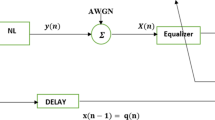Abstract
Aiming to the question of nonlinear interference which is caused by the high order signal modulation of satellite communications, and the question of obvious memory characteristics of the satellite channel, the existing equalization algorithms are difficult to quickly cancel the nonlinear interference and memory interference. This paper proposed a nonlinear revised error aided feedback equalization algorithm. Due to the nonlinear characteristics of amplitude and phase don’t interference with each other, so the amplitude and phase of the received signals are separated in first, then they utilize the feedback equalization to abate memory interference. In addition, the nonlinear interference of satellite channel would degrade the performance of satellite communication, the algorithm utilizes the three-order Volterra module to revise the nonlinear error and it is adapted to renews the parameters of feedback equalization to reduce the nonlinear interference. Our proposed algorithm utilized the nonlinear revised error instead of the nonlinear revised received signal to reduce the computation complexity and improve the nonlinear interference cancelation. In the simulation part, we compare the proposed equalization algorithm with the existing equalization algorithms in three parts of SER, convergence speed and computation complexity. The simulation and analysis results show that our proposed algorithm have better nonlinear interference cancelation and less computational complexity.








Similar content being viewed by others
References
Tang, C. K., Lian, B. W., & Zhang, Y. (2013). Dual loop feedback pre-distortion in satellite communication. Systems Engineering and Electronics, 24(4), 586–591.
Morel, C., Arapoglou, P.-D., & Angelone, M. (2015). Link adaptation strategies for next generation satellite video broadcasting: A system approach. IEEE Transactions on Broadcasting, 61(4), 603–614.
Song, H., & Brandt-Pearce, M. (2013). “Range of influence and impact of physical impairments in Long-Haul DWDM systems. IEEE/OSA Journal of Lightwave Technology, 31(6), 713–726.
Du, C. H., Sun, X., & Wang, Y. X. (2016). A variable step size LMS equalization algorithm in the satellite communication system. In Industrial Electronics and Applications (ICIEA), 2016 IEEE 11th Conference on (pp. 557–1562).
Chengkai, T., Baowang, L., & Lingling, Z. (2014). Post predistortion of 16APSK modulation with momory and nonlinear effect in satellite communication. Journal of Northwestern Polytechnical University, 32(6), 34–39.
Bauduin, M., Massar, S., & Horlin, F. (2016). Receiver design for non-linear satellite channels: Equalizer training and symbol detection on the compressed constellation. In Military Communications and Information Systems (ICMCIS), 2016 International Conference on (pp. 1–6).
Colonnese, S., Panci, G., Rinauro, S., & Scarano, G. (2009). Semiblind Bussgang equalization for sparse channels. IEEE Transactions on Signal Processing, 57(12), 4946–4952.
Sugiura, S., & Hanzo, L. (2015). Frequency-domain-equalization-aided iterative detection of faster-than-Nyquist signaling. IEEE Transactions on Vehicular Technology, 64(5), 2122–2128.
Chen, S., Hong, X., & Khalaf, E. F. (2016). Comparative performance of complex-valued B-spline and polynomial models applied to iterative frequency-domain decision feedback equalization of Hammerstein channels. IEEE Transactions on Neural Networks and Learning Systems, PP(99), 1–13.
Manuel, S., & Christian-Alexander, B. (2016). 5 Gb/s Eye-safe LED-based SI-POF transmission with equalization of transmitter nonlinearities. IEEE Photonics Technology Letters, 28(23), 2732–2735.
Kiayani, A., Anttila, L., & Zou, Y. N. (2016). Channel estimation and equalization in multiuser uplink OFDMA and SC-FDMA systems under transmitter RF impairments. IEEE Transactions on Vehicular Technology, 65(1), 82–99.
Song, H., & Brandt-Pearce, M. (2012). A 2-D discrete-time model of physical impairments in wavelength-division multiplexing systems. IEEE/OSA Journal of Lightwave Technology, 30(5), 846–854.
Lei, X., & Cottatellucci, L. (2012). Contention resolution and channel estimation in satellite random access channels. In Communications in China (ICCC), 2012 1st IEEE International on (pp. 562–567).
Tang, C. K., Lian, B. W., & Zhang, Y. (2015). An algorithm to eliminate self-interference of bidirectional relaying for satellite communication systems. Journal of Xi’an Jiaotong University, 49(2), 74–79.
Song, H., & Brandt-Pearce, M. (2013). Model-centric nonlinear equalizer for coherent long-haul fiber-optic communication systems. In Global Communications Conference (GLOBECOM), 2013 IEEE, Atlanta, GA (pp. 2394–2399).
Author information
Authors and Affiliations
Corresponding author
Rights and permissions
About this article
Cite this article
Tang, C., Zhang, L., Zhang, Y. et al. Nonlinear revised error aided feedback equalization in high-speed satellite communication. Telecommun Syst 66, 243–251 (2017). https://doi.org/10.1007/s11235-017-0282-7
Published:
Issue Date:
DOI: https://doi.org/10.1007/s11235-017-0282-7




